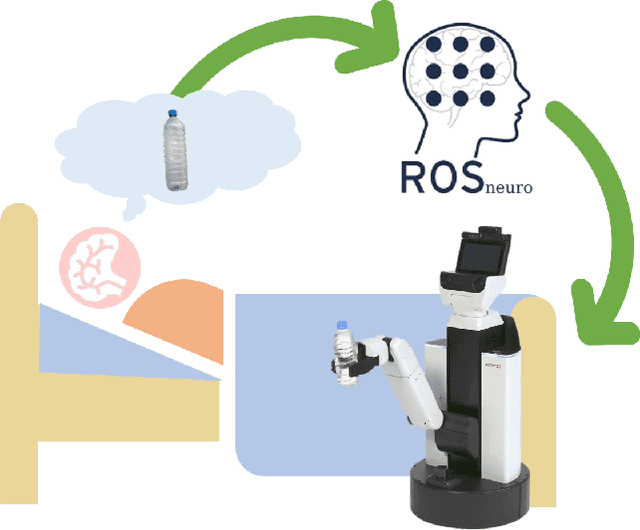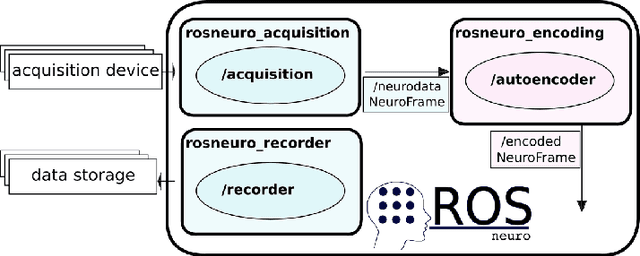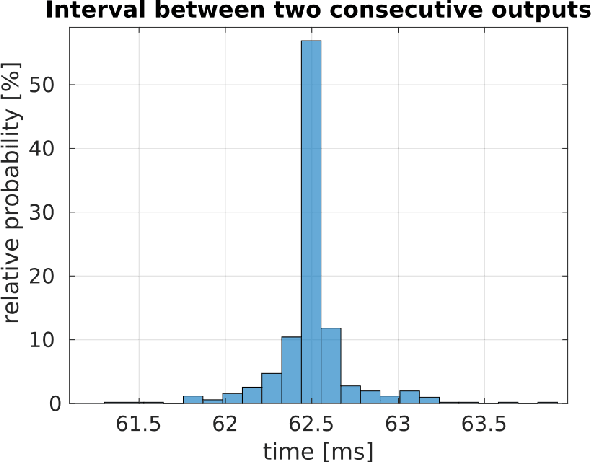Luca Ascari
ROS-Neuro Integration of Deep Convolutional Autoencoders for EEG Signal Compression in Real-time BCIs
Aug 31, 2020



Abstract:Typical EEG-based BCI applications require the computation of complex functions over the noisy EEG channels to be carried out in an efficient way. Deep learning algorithms are capable of learning flexible nonlinear functions directly from data, and their constant processing latency is perfect for their deployment into online BCI systems. However, it is crucial for the jitter of the processing system to be as low as possible, in order to avoid unpredictable behaviour that can ruin the system's overall usability. In this paper, we present a novel encoding method, based on on deep convolutional autoencoders, that is able to perform efficient compression of the raw EEG inputs. We deploy our model in a ROS-Neuro node, thus making it suitable for the integration in ROS-based BCI and robotic systems in real world scenarios. The experimental results show that our system is capable to generate meaningful compressed encoding preserving to original information contained in the raw input. They also show that the ROS-Neuro node is able to produce such encodings at a steady rate, with minimal jitter. We believe that our system can represent an important step towards the development of an effective BCI processing pipeline fully standardized in ROS-Neuro framework.
Brain-based control of car infotainment
Apr 24, 2020



Abstract:Nowadays, the possibility to run advanced AI on embedded systems allows natural interaction between humans and machines, especially in the automotive field. We present a custom portable EEG-based Brain-Computer Interface (BCI) that exploits Event-Related Potentials (ERPs) induced with an oddball experimental paradigm to control the infotainment menu of a car. A preliminary evaluation of the system was performed on 10 participants in a standard laboratory setting and while driving on a closed private track. The task consisted of repeated presentations of 6 different menu icons in oddball fashion. Subject-specific models were trained with different machine learning approaches on cerebral data from either only laboratory or driving experiments (in-lab and in-car models) or a combination of the two (hybrid model) to classify EEG responses to target and non-target stimuli. All models were tested on the subjects' last in-car sessions that were not used for the training. Analysis of ERPs amplitude showed statistically significant (p < 0.05) differences between the EEG responses associated with target and non-target icons, both in the laboratory and while driving. Classification Accuracy (CA) was above chance level for all subjects in all training configurations, with a deep CNN trained on the hybrid set achieving the highest scores (mean CA = 53 $\pm$ 12 %, with 16 % chance level for the 6-class discrimination). The ranking of the features importance provided by a classical BCI approach suggests an ERP-based discrimination between target and non-target responses. No statistical differences were observed between the CAs for the in-lab and in-car training sets, nor between the EEG responses in these conditions, indicating that the data collected in the standard laboratory setting could be readily used for a real driving application without a noticeable decrease in performance.
 Add to Chrome
Add to Chrome Add to Firefox
Add to Firefox Add to Edge
Add to Edge